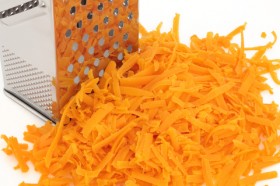Last Updated on February 7, 2021
 Pam recently e-mailed the Kitchenshrink to ask, “When I make a cheese sauce starting with a roux of flour and butter then adding milk and cheese it sometimes gets a gritty texture. What causes this?” I thought perhaps it was caused by overheating but wasn’t sure so I asked my friend Jean Anderson for some help. Here’s what she said:
Pam recently e-mailed the Kitchenshrink to ask, “When I make a cheese sauce starting with a roux of flour and butter then adding milk and cheese it sometimes gets a gritty texture. What causes this?” I thought perhaps it was caused by overheating but wasn’t sure so I asked my friend Jean Anderson for some help. Here’s what she said:
“I think some kinds of cheese just do this but it could be that overheating the cheese has denatured the protein. Some cheeses are improperly aged and in addition, contain emulsifiers or coagulants that break down when heated causing a gritty texture. I would urge cooks to use top-quality cheeses, PURE CHEESES and NOT “CHEESE FOODS” that glut supermarkets. READ THE LABELS and if the list of additives is long, avoid that particular cheese. Well aged, unadulterated top-quality Cheddars melt smoothly if NOT overheated. I also like the Italian Fontina and Parmigiano Reggiano. Something else: Grate the cheese yourself instead of using pre-grated — in my experience, these rarely melt smoothly. Rule of Thumb: Add cheese only after a sauce has thickened, use lowest heat, stir constantly, and remove from the heat the instant the cheese melts — but if the sauce is bubbling before you add the cheese, pull the pan off the heat altogether, add the cheese, and stir until smooth. Overheating cheese will curdle and/or “string” it every time. Easy does it!” For more kitchen wisdom, check out Jean’s many cookbooks at your local bookstore or on line.


